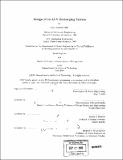| dc.contributor.advisor | Chryssostomos Chryssostomidis. | en_US |
| dc.contributor.author | Gish, Lynn Andrew | en_US |
| dc.contributor.other | Massachusetts Institute of Technology. Dept. of Ocean Engineering. | en_US |
| dc.date.accessioned | 2006-07-13T15:24:58Z | |
| dc.date.available | 2006-07-13T15:24:58Z | |
| dc.date.copyright | 2004 | en_US |
| dc.date.issued | 2004 | en_US |
| dc.identifier.uri | http://hdl.handle.net/1721.1/33445 | |
| dc.description | Thesis (Nav. E. and S.M.)--Massachusetts Institute of Technology, Dept. of Ocean Engineering, 2004. | en_US |
| dc.description | Includes bibliographical references (p. 111-115). | en_US |
| dc.description.abstract | The utility of present Autonomous Underwater Vehicles (AUVs) is limited by their on-board energy storage capability. Research indicates that rechargeable batteries will continue to be the AUV power source of choice for at least the near future. Thus, a need exists in both military and commercial markets for a universal, industry-standard underwater AUV recharge system. A novel solution using a linear coaxial wound transformer (LCWT) inductive coupling mounted on the AUV and a vertical docking cable is investigated. The docking cable may be deployed from either a fixed docking station or a mobile "tanker AUV". A numerical simulation of the simplified system hydrodynamics was created in MATLAB and used to evaluate the mechanical feasibility of the proposed system. The simulation tool calculated cable tension and AUV oscillation subsequent to the docking interaction. A prototype LCWT coupling was built and tested in saltwater to evaluate the power transfer efficiency of the system. The testing indicated that the surrounding medium has little effect on system performance. | en_US |
| dc.description.abstract | (cont.) Finally, an economic analysis was conducted to determine the impact of the proposed system on the present military and commercial AUV markets. The recharge system creates substantial cost-savings, mainly by reducing support ship requirements. An effective AUV recharge system will be an important element of the Navy's net-centric warfare concept, as well as a valuable tool for commercial marine industries. | en_US |
| dc.description.statementofresponsibility | by Lynn Andrew Gish. | en_US |
| dc.format.extent | 134 p. | en_US |
| dc.format.extent | 8367383 bytes | |
| dc.format.extent | 8372986 bytes | |
| dc.format.mimetype | application/pdf | |
| dc.format.mimetype | application/pdf | |
| dc.language.iso | eng | en_US |
| dc.publisher | Massachusetts Institute of Technology | en_US |
| dc.rights | M.I.T. theses are protected by copyright. They may be viewed from this source for any purpose, but reproduction or distribution in any format is prohibited without written permission. See provided URL for inquiries about permission. | en_US |
| dc.rights.uri | http://dspace.mit.edu/handle/1721.1/7582 | |
| dc.subject | Ocean Engineering. | en_US |
| dc.subject.lcsh | Remote submersibles | en_US |
| dc.subject.lcsh | Storage batteries | en_US |
| dc.title | Design of an AUV recharging system | en_US |
| dc.title.alternative | Design of an Autonomous Underwater Vehicle recharging system | en_US |
| dc.type | Thesis | en_US |
| dc.description.degree | Nav.E.and S.M. | en_US |
| dc.contributor.department | Massachusetts Institute of Technology. Department of Ocean Engineering | |
| dc.identifier.oclc | 62887131 | en_US |
